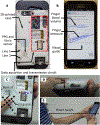Smartphone-based blood pressure monitoring via the oscillometric finger-pressing method
- PMID: 29515001
- PMCID: PMC6039119
- DOI: 10.1126/scitranslmed.aap8674
Smartphone-based blood pressure monitoring via the oscillometric finger-pressing method
Abstract
High blood pressure (BP) is a major cardiovascular risk factor that is treatable, yet hypertension awareness and control rates are low. Ubiquitous BP monitoring technology could improve hypertension management, but existing devices require an inflatable cuff and are not compatible with such anytime, anywhere measurement of BP. We extended the oscillometric principle, which is used by most automatic cuff devices, to develop a cuff-less BP monitoring device using a smartphone. As the user presses her/his finger against the smartphone, the external pressure of the underlying artery is steadily increased while the phone measures the applied pressure and resulting variable-amplitude blood volume oscillations. A smartphone application provides visual feedback to guide the amount of pressure applied over time via the finger pressing and computes systolic and diastolic BP from the measurements. We prospectively tested the smartphone-based device for real-time BP monitoring in human subjects to evaluate usability (n = 30) and accuracy against a standard automatic cuff-based device (n = 32). We likewise tested a finger cuff device, which uses the volume-clamp method of BP detection. About 90% of the users learned the finger actuation required by the smartphone-based device after one or two practice trials. The device yielded bias and precision errors of 3.3 and 8.8 mmHg for systolic BP and -5.6 and 7.7 mmHg for diastolic BP over a 40 to 50 mmHg range of BP. These errors were comparable to the finger cuff device. Cuff-less and calibration-free monitoring of systolic and diastolic BP may be feasible via a smartphone.
Copyright © 2018 The Authors, some rights reserved; exclusive licensee American Association for the Advancement of Science. No claim to original U.S. Government Works.
Figures







References
-
- Lewington S, Clarke R, Qizilbash N, Peto R, Collins R; Prospective Studies Collaboration, Age-specific relevance of usual blood pressure to vascular mortality: A meta-analysis of individual data for one million adults in 61 prospective studies. Lancet 360, 1903–1913 (2002). - PubMed
-
- Psaty BM, Smith NL, Siscovick DS, Koepsell TD, Weiss NS, Heckbert SR, Lemaitre N, Wagner EH, Furberg CD, Health outcomes associated with antihypertensive therapies used as first-line agents: A systematic review and meta-analysis. JAMA 277, 739–745 (1997). - PubMed
-
- Ibrahim MM, Damasceno A, Hypertension in developing countries. Lancet 380, 611–619 (2012). - PubMed
-
- Pickering TG, Shimbo D, Haas D, Ambulatory blood-pressure monitoring. N. Engl. J. Med 354, 2368–2374 (2006). - PubMed
-
- Agarwal R, Bills JE, Hecht TJW, Light RP, Role of home blood pressure monitoring in overcoming therapeutic inertia and improving hypertension control: A systematic review and meta-analysis. Hypertension 57, 29–38 (2011). - PubMed
Publication types
MeSH terms
Grants and funding
LinkOut - more resources
Full Text Sources
Other Literature Sources
Research Materials

